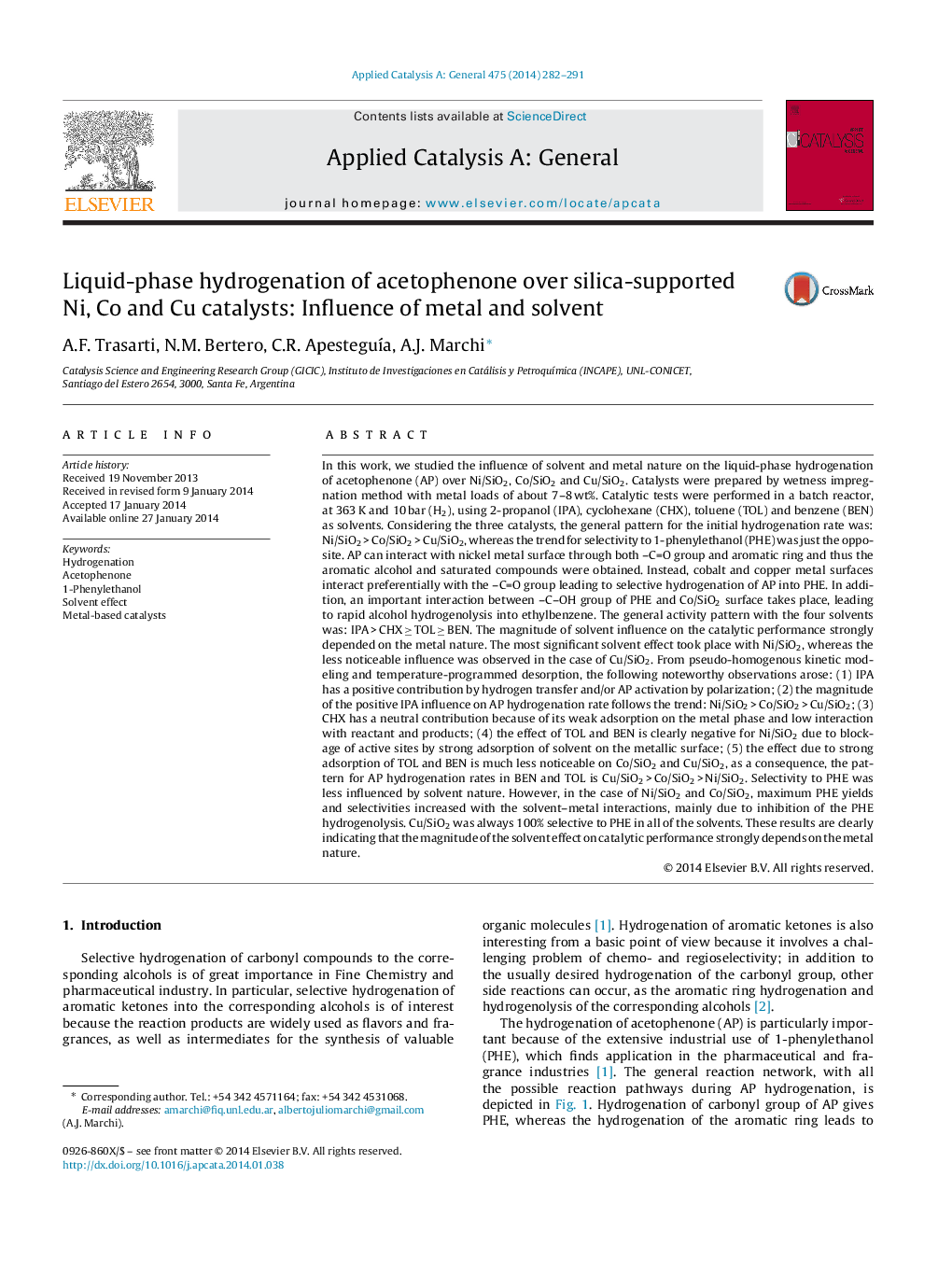| کد مقاله | کد نشریه | سال انتشار | مقاله انگلیسی | نسخه تمام متن |
|---|---|---|---|---|
| 39844 | 45837 | 2014 | 10 صفحه PDF | دانلود رایگان |

• Solvent–metal interactions rule the solvent effect on the acetophenone hydrogenation.
• The magnitude of the solvent effect strongly depends on the metal: Ni > Co > Cu.
• Benzene–metal and toluene–metal interactions hamper acetophenone hydrogenation rate.
• Both 2-propanol–metal and 2-propanol–reactant interactions promote hydrogenation rate.
• Strong solvent–metal interaction diminishes 1-phenylethanol hydrogenolysis.
In this work, we studied the influence of solvent and metal nature on the liquid-phase hydrogenation of acetophenone (AP) over Ni/SiO2, Co/SiO2 and Cu/SiO2. Catalysts were prepared by wetness impregnation method with metal loads of about 7–8 wt%. Catalytic tests were performed in a batch reactor, at 363 K and 10 bar (H2), using 2-propanol (IPA), cyclohexane (CHX), toluene (TOL) and benzene (BEN) as solvents. Considering the three catalysts, the general pattern for the initial hydrogenation rate was: Ni/SiO2 > Co/SiO2 > Cu/SiO2, whereas the trend for selectivity to 1-phenylethanol (PHE) was just the opposite. AP can interact with nickel metal surface through both –C=O group and aromatic ring and thus the aromatic alcohol and saturated compounds were obtained. Instead, cobalt and copper metal surfaces interact preferentially with the –C=O group leading to selective hydrogenation of AP into PHE. In addition, an important interaction between –C–OH group of PHE and Co/SiO2 surface takes place, leading to rapid alcohol hydrogenolysis into ethylbenzene. The general activity pattern with the four solvents was: IPA > CHX ≥ TOL ≥ BEN. The magnitude of solvent influence on the catalytic performance strongly depended on the metal nature. The most significant solvent effect took place with Ni/SiO2, whereas the less noticeable influence was observed in the case of Cu/SiO2. From pseudo-homogenous kinetic modeling and temperature-programmed desorption, the following noteworthy observations arose: (1) IPA has a positive contribution by hydrogen transfer and/or AP activation by polarization; (2) the magnitude of the positive IPA influence on AP hydrogenation rate follows the trend: Ni/SiO2 > Co/SiO2 > Cu/SiO2; (3) CHX has a neutral contribution because of its weak adsorption on the metal phase and low interaction with reactant and products; (4) the effect of TOL and BEN is clearly negative for Ni/SiO2 due to blockage of active sites by strong adsorption of solvent on the metallic surface; (5) the effect due to strong adsorption of TOL and BEN is much less noticeable on Co/SiO2 and Cu/SiO2, as a consequence, the pattern for AP hydrogenation rates in BEN and TOL is Cu/SiO2 > Co/SiO2 > Ni/SiO2. Selectivity to PHE was less influenced by solvent nature. However, in the case of Ni/SiO2 and Co/SiO2, maximum PHE yields and selectivities increased with the solvent–metal interactions, mainly due to inhibition of the PHE hydrogenolysis. Cu/SiO2 was always 100% selective to PHE in all of the solvents. These results are clearly indicating that the magnitude of the solvent effect on catalytic performance strongly depends on the metal nature.
Figure optionsDownload high-quality image (247 K)Download as PowerPoint slide
Journal: Applied Catalysis A: General - Volume 475, 5 April 2014, Pages 282–291